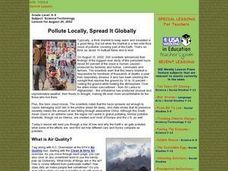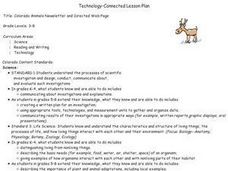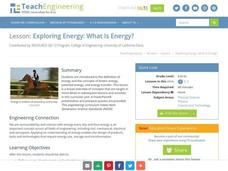Curated OER
Hide In Plain Sight
Students view video clips and use the Internet to look for hidden animals. They then use the Internet to print out animal shapes and color them. They create environments on construction paper in which their animals can hide.
Curated OER
Mollusk Matching
Young scholars look carefully at shells and observe the differences between
species and the names of common shells. Then they identify and complete a Mollusk Matching handout included in the instructional activity and write the letter of...
Curated OER
Meet the Plants
Students examine the difference between living and non-living things. In this living versus non-living lesson, students complete a KWL worksheet and a Living and Non-Living Chart. They examine a variety of plants and non-plants before...
Curated OER
The Rainforest
Students learn the characteristics of the rainforest. In this rainforest lesson, students read stories about the rainforest and discuss them. Students work in groups to brainstorm all the facts they know about the rainforest and then...
Curated OER
Polymerization Experiments
Learners study the concepts of polymerization and the function of crosslinkage. In this polymer activity students complete a lab activity and write down their observations.
Curated OER
Pollute Locally, Spread It Globally
Students examine the rate of pollution throughout the world through an interactive program. They define air quality and the air quality index. They examine fuel economy and its impact on the Earth and renewable and nonrenewable resources.
Alabama Learning Exchange
Plants, Soil and Nutrients
Young scholars conduct an experiment. They review how to use the scientific method to conduct an experiment with white carnations and food coloring. They create a hypothesis and test it to better understand how plants get nutrients,...
Curated OER
Understanding pH, Alkalinity, and Hardness
Students comprehend the interactions of pH, alkalinity, hardness, and carbon dioxide in aquaculture water. They read the SRAC fact sheet number 464 "Interactions of pH, Carbon Dioxide, Alkalintiy and Hardness in Fish Ponds." Students...
Curated OER
All Sorts of Seeds!
First graders compare seeds and explore how they are carried through the environment.
Curated OER
Gardens Under the Sea: Coral Reefs
Students, with dive partners, explore coral reefs through scuba diving. They also explore radial symmetry and bilateral symmetry.
Curated OER
Get to Know- Insects, Spiders and Others
Students investigate live insects. For this insects and spiders lesson, students work in groups to explore the outdoors and capture insects. Students observe, discuss and record information about the insects they discover. Students...
Curated OER
Colorado Animals Newsletter and Directed Web Page
Young scholars select a Colorado animal, develop a Directed Web page, and research their animal. Each member of the group combine their research and develop a Newsletter.
Curated OER
Honing in on Hummingbirds
Students explore ruby-throated hummingbirds. In this cross-curricular hummingbirds lesson, students listen to the book The Mystery of the Missing Hummingbirds and choose related topics to research with a partner. Students draw or write...
Benjamin Franklin Tercentenary
Guess What Benjamin Franklin Did!
Students research Ben Franklin's inventions. In this invention lesson, students see the relationship between a need and an invention. Students will engage in a class discussion, read a handout, and play a match the invention to its...
Curated OER
Infrared-Hot
Students describe how the sun heats the Earth, explain the nature of infrared light, explain how thunderstorms are formed and use infrared maps to predict severe weather.
Teach Engineering
Exploring Energy: What Is Energy?
...Then the water heater exploded like a bomb. Using a video of an exploding water heater, the resource presents the definitions of energy, potential energy, and kinetic energy to be used in later lessons of the unit.
Global Oneness Project
The Value of Ancient Traditions
Imagine having to give up cell phones, computers, and TV? What would be lost? What gained? An examination of the Drokpa, a nomadic people who live in the grasslands of Tibet, provides class members an opportunity to consider how access...
Teach Engineering
The Grand Challenge
Magnetic resonance imaging, just how safe is it? The introduction to unit study of magnetic resonance imaging technology presents the grand challenge questions of how an MRI machine works, the risks involved, the physics involved, and...
Teach Engineering
The Keepers of the Gate Challenge
Help your class make a connection between salt water and nanoscience. In the introductory lesson of a seven-part unit, the class explores why salt water helps a sore throat feel better. Pupils conduct preliminary research about the...
Curated OER
Dichotomous Keys
Students define the word dichotomous and explain why a dichotomous key is a useful tool in identifying different species. Then they look up words they are unfamiliar with or mollusk reference books so students can
learn the names of...
Other popular searches
- K 2 Life Science Growth
- K 2 Life Science Living
- K 2 Life Science Insects
- K 2 Life Science Salamander
- K 2 Life Science Hibernation
- K 2 Life Science Adaptation
- K 2 Life Science Cells
- K 2 Life Science Nonliving
- K 2 Life Science Wind





















